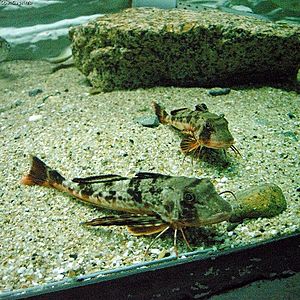Gurnards facts for kids
Quick facts for kids Sea robin |
|
|---|---|
 |
|
| Red gurnard, Chelidonichthys spinosus | |
| Scientific classification |
|
| Kingdom: | Animalia |
| Phylum: | Chordata |
| Class: | Actinopterygii |
| Order: | Scorpaeniformes |
| Suborder: | Scorpaenoidei |
| Family: | Triglidae A. Risso, 1826 |
| Genera | |
|
Bellator |
|
The Triglidae, often called sea robins or gurnard, are a group of fish that live near the bottom of the ocean. They belong to a larger order of fish called Scorpaeniformes.
Sea robins get their name because some kinds, like the Prionotus carolinus from the Western Atlantic, have a bright orange belly. Their large pectoral fins also look a bit like a bird's wings, which might remind you of a robin.
These fish usually live on the seafloor, sometimes as deep as 200 meters (about 650 feet). But you can also find them in much shallower waters. Most sea robins grow to be about 30 to 40 centimeters (12 to 16 inches) long.
They have a very strong skull and many species have tough, armored plates on their bodies. Sea robins also have a special "drumming muscle." This muscle beats against their swim bladder, which is like an air sac, to make sounds. When a sea robin is caught, it often makes a croaking noise, much like a frog. This sound is why they are also called "gurnard," a name that sounds like the noise they make.
Amazing Walking Fins
Sea robins have a unique feature: three special "walking rays" on each side of their body. These rays come from their pectoral fins. As the fish grow, these parts of the fin separate and become strong, finger-like structures.
These walking rays have special muscles and a unique design. This allows sea robins to use them to move around on the ocean floor. They don't just walk; these rays are also super sensitive! They can detect tiny amounts of chemicals, like amino acids, that come from small sea creatures. This helps the sea robin find its next meal hidden in the sand or mud.
Sea Robins as Food
Gurnard fish have firm, white meat that stays together well when cooked. This makes them great for adding to soups and stews. They are a common ingredient in a famous French soup called bouillabaisse.
For a long time, gurnards were often caught by accident in British waters and thrown back. However, as other popular fish became harder to find and more expensive, gurnards became much more popular. Between 2007 and 2008, their price went up a lot, and sales increased ten times by 2011. Now, you can also find gurnards in fish markets in the United States.
Fishing for Sea Robins
You can catch sea robins by dropping different kinds of bait and lures to the bottom of the ocean, where they actively look for food. Many people believe that mackerel is the best bait for catching them. However, crabs, bunker fish, and other types of fish meat can also work well, depending on where you are fishing.
Sea robins can also be caught using lures if the lure is kept close to the seafloor. Sometimes, people consider them a "rough fish" because they are often caught when anglers are trying to catch more popular fish, like striped bass or flounder. But sea robins are also useful! For example, lobster fishermen sometimes use them as bait to catch lobsters.
See also
 In Spanish: Triglidae para niños
In Spanish: Triglidae para niños

